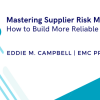5 Ways to Prepare for the Next Supply Chain Crisis
With the impacts of COVID-19 still being felt around the world, it’s hard to look ahead at what might be coming next. But you should.
The COVID-19 pandemic brought a truly unprecedented level of disruption to global supply chains, bringing entire industries to a complete halt. It was unlike any supply chain crisis we’ve seen in modern times, but it was far from an isolated incident.
Over the past two decades, the volume, velocity and supply chain impacts of crisis events around the world have increased significantly. For those managing operations that touch every corner of the globe, mitigating the negative impacts of “once-in-a-lifetime” events have become part of their daily routine.
With many organizations still dealing with the economic fallout of the 2020 pandemic, looking ahead to the hypothetical crises of the future might not be too high on your agenda today – but it should be.
We don’t know what the next crisis will be. We don’t know where it will happen. And we don’t even know how it will affect supply chains. What we do know is that it’s coming – and current trends suggest it may come sooner rather than later.
Preparing for the unforeseen is difficult. But here are five things you can do to ensure that when the unforeseen does come, you’re able to take the right strategic response immediately.
1) Start by Assessing the Impact on Demand
When a crisis happens, the first thought many procurement leaders have is typically how will this impact our ability to meet demand? But, before you can answer that question, you should first consider the impact the event will have on demand itself.
There’s no use desperately trying to maintain current production levels if demand is likely to dip. That approach quickly leads to overstocking and overspending – a potentially deadly combination during a time of deflated customer demand.
Understanding both short- and long-term demand levels is the first step toward a strong strategic crisis response. It helps you define the optimal level of output, which will inform the rest of your supply chain decisions.
2) Rebalance the Supply Chain Accordingly
Once you understand what demand levels are likely to look like in the “new normal,” you can start making informed decisions about how to optimize your supply chains.
For example, if supply is limited or rising in cost in a particular region, are there viable short-term alternatives to help you meet new demand levels? If so, does making those supply chain changes carry any hidden costs that may harm profitability?
At this stage, your focus is likely to be on ensuring you can meet demand today and tomorrow, to get through the crisis. However, this is also an opportunity to make valuable long-term supply chain changes. The changes you make now may stick, and become your own new normal, so it’s worth considering their long-term implications.
3) Reassess How You Operate
Crises are external disruptions to your categories, markets and operations. But there are powerful internal changes you can make to mitigate their impact, and not just recover, but emerge from them in a stronger position than you started.
A new normal means new a definition of success. How could your procurement operations evolve to meet that definition? Could you be making better use of digital technology to streamline processes? And is this new definition of success actually achievable with your current operating model?
A crisis creates valuable opportunities for change. It’s a chance to define a new normal for your organisation, as much as it’s about adapting to a new normal in your categories and markets.
4) Rethink Your Category Strategies
One of the biggest challenges of crisis management in procurement is that, in an instant, these events can completely invalidate everything you’ve learned about your categories. Prices, logistics, alternatives, supply reliability – so many parameters are likely to have changed.
To prepare for the future, you need to totally rethink your category strategies. Gather new intelligence, start at the most fundamental level and begin by asking important questions such as these:
- Which categories have been worst affected? Where are our current strategies most likely to have been invalidated?
- How have demand profiles and supply market characteristics changed? Who has survived, who hasn’t, and how does that impact our ability to get the right goods and materials at the right cost?
- How could contracts change to support future continuity? How could we renegotiate contracts now to keep prices consistent when future disruptive events happen?
5) Re-evaluate Your Suppliers
When a crisis strikes, you’ll learn a lot about your suppliers and how resilient they really are. This is a great time to look at which suppliers have remained strong, which haven’t been able to adapt, and which standout stars have delivered consistently, without any changes to price or contract terms.
It’s also a good idea to look at how other suppliers in your categories have fared. More resilient options that you’ve previously overlooked may emerge and can play a vital role to help you ensure continuity during the next crisis.
The same questions can be asked of specific regions, countries or even cities. Are there areas that were slow to respond, slow to recover or that were particularly vulnerable to the crisis? If so, is that likely to be the case again if a similar event happens? Asking questions like these can help you identify regions to prioritize and deprioritize across your supplier base, so you can build a more resilient portfolio and supply chain.
While you’re re-evaluating, it’s important to keep the value of supplier relationships in mind. A strong relationship with a key supplier can be a huge advantage in times of crisis. You support one another and go above and beyond to continue trading as usual, which is hugely valuable when you don’t know what the next day may bring for your business. Your evaluation may find more cost-effective or more resilient suppliers, but it’s up to you to decide if it’s worth sacrificing current relationships to switch to new alternatives.
Structure is Everything
Many of those steps seem like common sense, but the real value lies in approaching them in a deliberate, structured way.
Procurement and supply chain teams are constantly doing the kinds of re-evaluation I’ve talked about here in times of crisis. But few approach them with the structure, care and consideration needed to make the right strategic decisions.
Moving through these actions carefully, in a structured and considered way, can help you make decisions that don’t just keep your business operational in the short term, but also optimize your supply chain in the long term.









